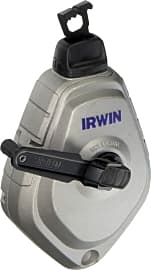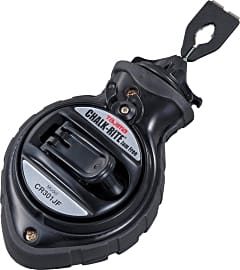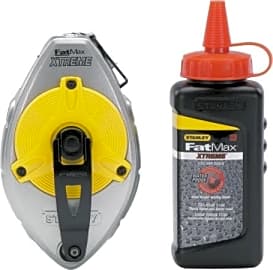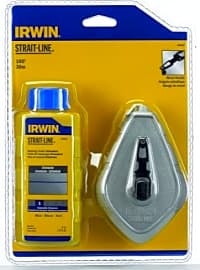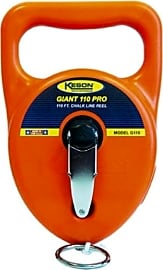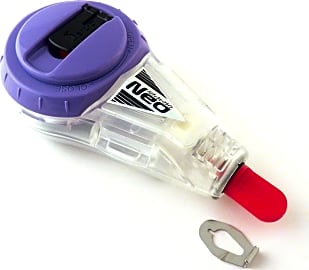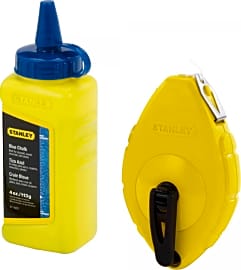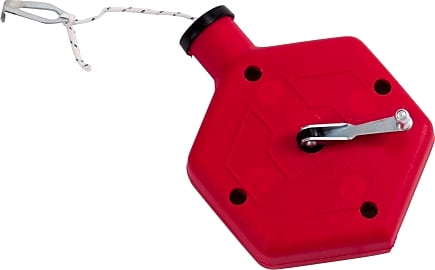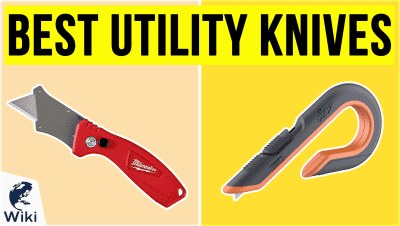The 10 Best Chalk Lines

This wiki has been updated 34 times since it was first published in October of 2016. When building a wall, installing flooring or laying tile, applying a straight marker guide is essential for a properly finished project. These chalk lines will enable any contractor or at-home amateur carpenter to easily finish a job with precision and accuracy. We have included large models for construction and framing, along with smaller variations for detailed work. When users buy our independently chosen editorial recommendations, we may earn commissions to help fund the Wiki.
Editor's Notes
April 29, 2021:
We made it through this round of updates without making any earth-shattering alterations. We did notice that the DeWalt DWHT47142 was unavailable, but as it wasn’t marked as discontinued on the company’s website, we assumed that the tool’s availability issues were due to some sort of temporary supply shortage. While a lot of tool companies still seem to be struggling with the whole internet thing, DeWalt is one shop that’s done a good job with their digital marketing, and we’d typically expect to see a tool identified as discontinued on their website before third-party vendors were sold out.
We redirected our ranking for the Irwin Tools Classic 64499 toward the Irwin Tools Classic 1932880, even though it seems like they’re extremely similar (and potentially exactly the same), because the latter option was more affordable. The Classic is a good mid-range model, and a logical step up from the Stanley 47-442, but we wanted our list to also include the company’s best, so we added the Irwin Tools Mach6 1932877. (For anybody who’s a bit confused at this point, note that Stanley and Irwin, as well as DeWalt, are all owned by the same parent company.)
The Mach6 has an aluminum housing that’s similar to the Classic, but sets itself well apart with a 6:1 gear ratio that puts it right in line with our top pick: the Milwaukee 48-22-3982. It’s also one of two options offered by Irwin that uses a high-tensile string, so you can expect it to last quite a bit longer than alternatives.
For next-level lining-up solutions supported by modern technology, you might also be interested in checking out our list of line lasers.
March 25, 2020:
Added the Dewalt 47142 and the Stanley FatMax 47-487L.
When looking for a chalk line, there are a few things that really make a huge difference in how much time you'll be spending on lay out. The first thing you want to look for is a chalk line that will adequately cover the line with chalk so that your line is clear and so that you won't have to respool and repeat it. The Milwaukee 48-22 and the Dewalt 47142 both do a great job at this, along with having a convenient quick-release on their handles. Simply put, it makes a chalk line very annoying to use without the quick-release function. When you're laying out a line (particularly in construction), you'll often set the hook and then walk back to your end point. Without a quick-release, what happens is that if your hand isn't clear of the handle (which it often isn't), it'll get caught and jam the mechanism.
The Milwaukee sets itself apart with its 6:1 gear ratio. All this means is that the input gear (attached to the handle) is larger and has a higher tooth count than the output gear (the output gear spools the line). Since the gear ratio is 6:1, for every full revolution of the input gear, the output gear spins six times, which means that you can wind the line very quickly and save time.
Special Honors
Keson On top of offering a great lineup of chalk lines, this company also keeps a nice selection of American-made marking chalk on hand. In addition to the standard sort, they also stock a few specialty powders, including permanent, semi-permanent and high-visibility varieties. keson.com
Bosch GLL3-330CG There's no doubt that a chalk line is a tried-and-true implement that virtually every handyperson should keep on hand, but that doesn't stop them from being messy and frustrating at times. If you're tired cleaning up after every time your line busts open inside your tool bag, a more elegant solution that might be worth considering is a laser line like this one. Self-levelling units with app connectivity and strong warranties, like the GLL3-330CG, are fantastic and can work wonders, but they can also be quite costly. If you aren't willing to cough up quite that much, don't despair, there's also budget models on the market that will still work well for basic jobs. boschtools.com
Putting An Old-School Tool To Good Use
Hold down the end point firmly with your thumb, or, if the line is quite long, drive in a temporary screw or nail at the end point to keep it in place.
Today’s students are fortunate enough to have myriad learning tools at their disposal — computers, tablets, dry erase boards — but this wasn’t always the case. Those of a certain generation fondly (or not so fondly) remember days in the classroom getting their hands dirty as they scribbled notes and equations on a good, old-fashioned chalkboard.
Many of those same folks probably haven’t given chalk a second thought since, relegating it to memories of their early education. If they entered the trades, however, that likely isn’t the case — indeed, plenty of professionals in these occupations still use chalk on a regular basis.
Take a roofer, for example. When a roofer lays shingles, he or she will want to make sure to lay them out along precise horizontal and vertical lines. An accurately applied chalk marking makes simple work of this task, generating a clear outline that indicates exactly where to deploy each row of singles.
For carpenters, electricians, and plumbers, marking straight lines on a job site is commonplace, as it takes the guesswork out of laying pipe, installing wiring, and framing walls. Before the use of chalk lines became widespread, some projects would require lining up a long straight edge over multiple segments to achieve an extensive line — doable, but far from efficient. Modern day tradesmen literally accomplish this in a snap.
Do-it-yourself home improvement enthusiasts will find value in a quality chalk line, as well, particularly when it comes to painting striped walls, installing wallpaper, or hanging decorations that they would like to keep level.
If you’ve never used a chalk line before, that’s nothing to fret about — a few straightforward steps, outlined below, are all it requires:
Load the tool with chalk, shake it up, then hook one end of the snap line to your starting point. If it has a crank, use this to minimize the strain on the line.
Hold down the end point firmly with your thumb, or, if the line is quite long, drive in a temporary screw or nail at the end point to keep it in place.
Make sure the line is taut against the surface with no gaps. Then, draw back the line about an inch — like you would a bow and arrow — and snap it.
Voila, you’ve marked a clear, straight line. That wasn’t so difficult, was it?
Does Your Device Measure Up?
Though most chalk lines are similar in design, there are certain attributes to keep in mind depending on your personal preferences and the type of jobs you have planned.
Right off the bat, you should carefully consider the color of the chalk, because in this case, not all colors are created equal. Blue is the most common, all-purpose color, since you can easily remove it from a non-porous surface. It’s ideal for use on white or light-colored surfaces, making it suitable for indoor projects like hanging drywall, trim work, and installing flooring.
Right off the bat, you should carefully consider the color of the chalk, because in this case, not all colors are created equal.
When your job takes place out in the elements — roofing, road work, or a similar application — permanence is a higher priority. Black and red work well in these situations, depending on the color of the surface to which you’ll be applying the line. Plumbers and electricians who spend time working in low-light areas like crawl spaces and attics tend to prefer fluorescent orange or yellow for high visibility in these dark spaces.
You’ll also want to assess how you’ll be holding the tool, as a strong, comfortable grip can make all the difference in the world, especially if you’ll be using it for extended periods of time. The same goes for its rewind mechanism — you’ll want to make sure this is smooth and easy, which will save you time and help prevent the onset of fatigue.
If you’re a professional in the trades, durability is a key factor. It won’t take long for a rugged work environment to dispose of a cheap, flimsy chalk line. A tough, resilient casing is critical, preferably one made from aluminum or stainless steel for resistance to corrosion.
A chalk line is only as effective as its hook, so make sure you take the time to examine this component of the tool. Ideally, it’s a large, versatile end clasp that you can easily attach to nails, screws, ledges, and other common surfaces to ensure it doesn’t detach itself in the middle of a job.
From Prehistoric Rock To Modern Day Tool
Chalk originated about 90 million years ago — that’s 24 million years before the dinosaurs went extinct, for those of you keeping track — in northern Europe.
As microscopic shells called coccoliths extracted calcite from sea water over millions of years, they gradually built up layer by layer until they consolidated themselves into rock. Eventually, earth movements raised these former sea-floor deposits above sea level, which would eventually make them accessible to humans.
Classes were growing larger, and teachers needed an efficient way to convey information to large groups of students simultaneously.
Once our early ancestors found chalk in nature, they used it to craft some of the first cave drawings. In later centuries, artists formed chalk into sticks, which they began to utilize for drawings and sketches.
It was not easy for these early creative folks — in order to turn natural chalk into an easy-to-wield artist’s instrument, they had to first grind it into a fine powder. They would then combine the powder with water and clay for binding, add pigments to alter the color, and roll the substance into individual cylinders, which they would allow to dry until they hardened.
Once the 19th century rolled around, chalk became a standard item in the classroom. Classes were growing larger, and teachers needed an efficient way to convey information to large groups of students simultaneously. It was still expensive to produce paper during this time, which is one reason small individual chalkboards became so popular, especially for young students.
In the early days, chalk often generated a cloud of dust, which was unhealthy to breathe in and a nuisance in the classroom. Today, almost all chalk is practically dustless, which manufacturers accomplish by baking the chalk longer to make it extra hard.


